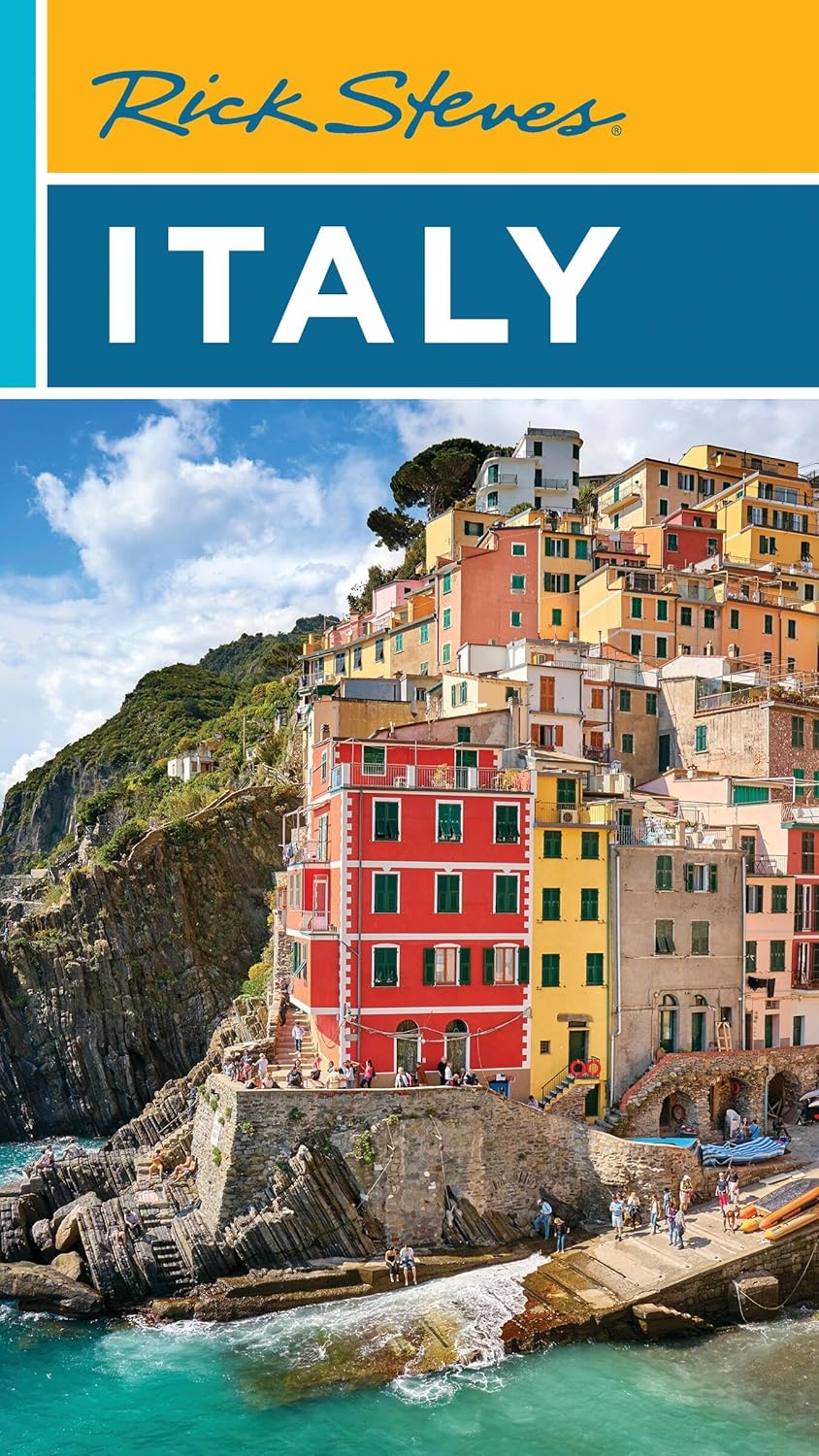Strange animal facts: animals in Italy and Italian superstitions
This is a page of strange animal facts from Italy. It looks at Italian superstitions, and generally interesting facts about animals in Italy's culture. It's an Italian-eye view of pets, owners and their eccentricities, a page of unusual, funny, entertaining and sometimes strange animal facts for kids and adults alike.
Italy is a theatrical, exciting culture - even, some might say, a bit eccentric, which we think is part of the joy of visiting or living in Italy. The Italians' perception and treatment of animals often reflects that passionate, exhilarating, offbeat, crazily melodramatic culture.
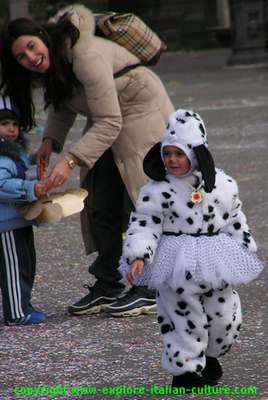
As Monica Cirinna, a local counsellor in Rome, commented recently:
"It's good to do whatever we can for our pets who, in exchange for a little love, fill our existence with their attention."
Strange Animal Facts
But do the Italians go too far - or not far enough? Here are ten strange animal facts about Italian animals. Read and decide for yourself!
Strange animal facts - Number one: Animals in Italy love ice cream as much as their owners do!
Italians have three main loves in the world: their mother, their pets, and 'gelato' - gorgeous Italian ice cream. Put the three together and you have the loveliest of European doggy treats and the first of our strange animal facts : 'Doghissimo', an Italian ice cream for pooches just like mamma used to make.
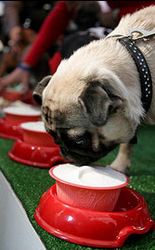
In the heat of the summer of 2007 Simona Leonardini, an Italian woman and owner of 'Iroy', a 'gelato' shop in Vienna, noticed her customers buying one ice cream for themselves and another for their dog. Knowing that dairy products can be harmful to animals Signora Leonardini decided to fill a gap in the market and, with the co-operation of a local vet, designed and made the first Italian doggy ice cream.
'Doghissimo' has no fat, sugar or artificial colourings but is still based on Signora Leonardini's own recipe for traditional Italian ice cream. Initially tested on her three Golden Retrievers, it took nearly a year before the recipe was approved by the authorities. It is one of many strange animal facts that in Italy the regulations for pooches' ice cream are as strict (or stricter!) than for the human variety.
So if you're travelling with a dog anywhere near Vienna, drop in and have one! The doggy-cream comes in three flavours : vanilla, rice, and soya, with vanilla apparently the pooches' favourite. Dog owners flock to the ice cream shop to purchase the doggy gelato, despite the high price tag of 4 Euros (about £3 or 6$) for a small pot and 7 Euros (about £6 or $9) for the large size.
And the icing on the ice cream cone? - a chunky dog biscuit in place of the usual chocolate flake.
Strange animal facts - Number two: Italian spa resorts are not just for humans!
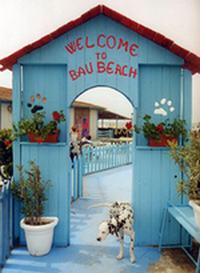
Just supposing you can't manage to get to Vienna to buy your doggy ice cream. What can you do to help your pampered pooches cool off in the summer heat of Italy? Why, take them to one of Italy's dog friendly beaches of course!
It is well known that on the first weekend in August each year Italians head, en masse, for the coast. It is one of the less pleasant strange animal facts in this otherwise largely pet-friendly culture that when they do, many pets are abandoned because families can't find animal-friendly resorts.
So in 1998, to try to help the worsening problem with stray animals, Bau Beach opened its doors.
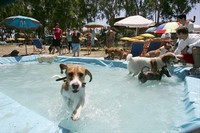
A spa, massage parlour, restaurant, doggy creche, play centre, re-homing centre and veterinary centre all rolled into one, Bau Beach is one of the best Italian beaches designed for the total pleasure of pet dogs. Instead of sitting cooped up in a hot car, dogs can relax on the beach; dogs who don't like sea salt water or are scared of the waves have their own pool to cool off in, showers to get rid of all that sand in their coats, and a complimentary flea treatment when they leave - just in case.
Usually prohibited from swimming on Italy's beaches, dogs here are positively encouraged to frolic in the waves. Tired from too much swimming? There are areas for the dogs to socialise and play, umbrellas (with special hooks for leads, naturally) to laze under and, when the munchies hit, a restaurant providing wholesome, organic doggy snacks.
And for those stressed-out pooches who don't seem able to relax, there are massage areas as well as animal psychologists and professional trainers on site, and vets for any unfortunate incidents. The whole structure has been authorised by the local authority which also provides the on-location veterinary services.
Strange animal facts? Maybe. But an average day sees something around eighty dogs and their owners sunning themselves at Bau Beach. In fact, the idea was so popular that the concept of the pet spa has now taken off and other dog friendly beaches have opened right around Italy's coastline.
Strange animal facts - Number three: Animals in Italy speak Italian
Here is one of many interesting animal facts for kids.
Why is 'Bau Beach' so called? Because the Italian animal noise for a dog is "bau bau".
Given that the Italian language is spoken exactly as it's written, the sound is virtually the same as the English "Bow (wow)".
It shouldn't be surprising that sounds are different depending on your native tongue. Language isn't only about grammar and pronunciation, it's about what you hear and how you interpret that sound. Being immersed in a particular language will affect how you hear and then speak natural sounds and other noises.
So Italian, like any other language, represents animal sounds differently than an English speaker might expect and the noises attributed to animals aren't so much strange animal facts as a reflection of how humans interpret sound.
What about other animals? How do they sound to an Italian person? Below is an animal fact file : noises and the phonetic spelling that most closely represents the sound :
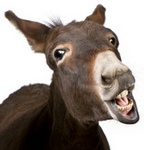
Donkeys (gli asini) go "i-oo, i-oo" (pronounced "eee-oo").
Roosters (i galli) go "chicchirichí" (pronounced kee-kee-ree-keeeee").
Hens (le galline) go "coccodè" (pronounced "cock-o-day").
Chicks (i pulcini) go "pio pio" (pronounced peeo).
Birds (gli uccelli) go "cip cip" (pronounced exactly as the English : "cheep cheep").
Crows (i corvi) go "cra cra" ...
... and it's one of those strange animal facts that frogs (le rane) sound the same - "cra cra".
Cuckoos (i cuculi) go "cucú, cucú, cucú".
Bees (le api) go "zzzzzz".
Cows (le mucche) go "muuuuuu".
Geese (le oche) go "qua qua".
Sheep (le pecore) go "beeee".
Mice (i topi) go "squitt squitt".
... and cats (i gatti) obviously speak English - they go "miao".
Or should that be English cats speak Italian?
Strange animal facts - Number four: cats have added a new word to the Italian language
Let's stick with language for a moment.
If you have visited Rome and you're at all struck by interesting facts about animals the chances are you will be aware of the famous "gatti di Roma" - the cats of Rome. You can even buy calendars of them. What you may not have heard of is a relatively new word in the Italian language - "gattara" - catwoman. No, not Halle Berry ...
Every tourist coming to Rome notices the cats. Most also realise there is a big difference between their own cuddly pet 'moggy' and the hundreds of cats which wander the ancient monuments. Aloof and arrogant, the cats of Rome are mostly feral, answering to no-one, doing what they want when they want to do it.
But if you have seen these cats you may also have noticed that they are generally well fed - some would even say a bit on the plump side for Italian animals.
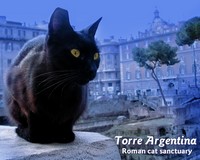
That's because since 1929 when cats colonized the Torre Argentina in the centre of Rome they were fed, first unofficially but from 1993 on a more formal basis, by a succession of mostly female cat-lovers who were worried about the cats' welfare and the fact that their breeding was out of control.
Since then this cat sanctuary has become famous for its work caring for and sterilizing Rome's cats. By the end of 2007 a total of 3,722 cats had been sterilized and 174 adopted, sometimes by Italians but also by cat-lovers from as far afield as America and Australia.
The succession of dedicated women who have worked at the sanctuary, the most famous of whom was Italian film star Anna Magnani, has included bank directors and lawyers, as well as the more ordinary "gattare" whose daily pilgrimages are a fixture of Roman life.
So it's a tribute to the cats of Rome, and one of Italy's many strange animal facts, that the cat has contributed to Italian culture not only by reducing the rodent population but by enriching the country’s language.
Strange animal facts - Number five: there's no tripe for cats
And talking about enriching the Italian language ...
In May 2007 at the Champions League soccer cup final in Athens, a group of A. C. Milan soccer fans unfurled a banner saying (in English) "There’s no tripe for cats". It made absolute sense to the Italian supporters but was completely lost on the English opposition.
That's because that literal translation of "non c'e trippa per gatti" doesn't make a lot of sense to anyone but Italians. To Italians, it means "there is absolutely no hope of you getting whatever it is you want". So Milan supporters were right, because that night Liverpool lost 2 - 1.
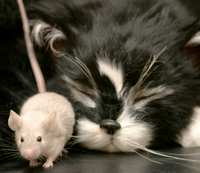
As well as taking ownership of many of the ancient monuments of Rome and adding words to the Italian language, it is one of those strange animal facts that cats, more than any other creature, play a central role in Italian superstitions and Italian animal sayings and proverbs which, translated into other languages, have nothing at all to do with cats - or often, with any other animal.
For instance, "ho altre gatte da pelare" - literally "I have other cats to skin" equates to the English saying: "I have other fish to fry"; "belle parole non pascono i gatti" - "fine words don't feed cats", the English equivalent being "fine words butter no parsnips" - in other words talking about something doesn't get it done.
And then there's "la gatta frettolosa fece i gattini ciechi" - "the hurried cat produces blind kittens" which may be most closely translated by the proverb: "haste makes waste".
Different regions in Italy also have their own feline proverbs. According to the Tuscans, "Al buio ogni gatta è morella" of which the closest English translation is "all cats look grey in the dark". The Sicilian dialect uses the expression "figghia di gatta mancia surci", literally "the daughter of the cat eats mice" or less literally, "like mother, like daughter".
If it's right to say that through sayings and proverbs we learn a lot about the tradition and culture of a country, then obviously cats play an important role in Italian life. But despite their popularity, cats in Italy don't seem to enjoy as long a life as cats elsewhere in the world. The Italians say "i gatti hanno sette spiriti" or "cats have seven spirits".
So it's another one of those strange animal facts that Italian cats, loved as they are, have six more lives than other creatures but two fewer than their counterparts in other cultures, where cats are said to have nine lives.
Strange animal facts - Number six: The Pope scoffs at Italian superstitions and says "Yay" to black cats
While we're talking about cats, let's consider the plight of the poor black cat. In the U.K. we would fight for the chance to have a black cat cross our path on the night of the national lottery - it's a sign of good luck. But it's one of Italy's strange animal facts that black cats are not only a bad omen - they are positively hated.
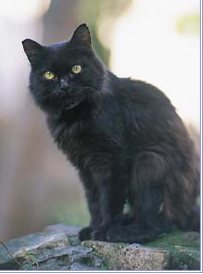
It's one of the less pleasant interesting facts about animals in Italy that this traditionally Catholic country frequently burnt black cats at the stake along with "witches" in the middle ages, following a papal decree declaring the creatures tools of the devil.
Italy can be a very superstitious country and killing black cats has far outlasted the fashion for burning witches. The Italian Association for the Defence of Animals and the Environment (AIDAA) believes that around sixty thousand black cats were killed last year, most of them for no good reason.
Here's where this story becomes one of Italy's even more strange animal facts. To try to change this groundless view of black cats, AIDAA introduced 'National Black Cat Day' in cities across the country, including Milan and Rome. The day has been celebrated on 27 November since 2007.
Events include displays of artwork celebrating black cats, picnics to which people bring their cats, and awards for people who have protected black cats. President of the AIDAA, Lorenzo Croce, outlined its aim as "to halt the massacre, educate people and restore dignity to black cats".
And as well as passing out literature, attempting to find homes for black cats, and seek signatures for a petition, Sr Croce attempted to enlist the support of known cat enthusiast and current Pope Benedict I in the campaign. In his days as Cardinal Ratzinger, Pope Benedict was known to look after stray cats in Rome. Whether he agreed or not with the black cat campaign was never publicized.
Strange animal facts - Number seven: Italian goldfish have rights too
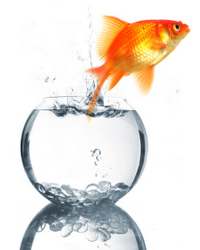
Let's stay in Rome for a minute.
The Italian government loves red tape. Anyone who has had anything to do with Italian bureaucracy will know exactly how murky the waters can be. And as far as laws about animals in Italy are concerned the waters just get deeper and make for yet more strange animal facts.
For example in the City of Rome, in a scheme known as the 'Fish Empathy Project', round goldfish bowls have been banned.
Difficult to clean, too small to allow enough oxygen for the fish to be comfortable and believed to make fish blind, bowls have been defined as cruel by Monica Cirinna, a local Roman councillor - and a local animal welfare group supported her decision to make the bowls illegal: "Rome stands out for recognising that fish are interesting individuals who deserve our respect and compassion every bit as much as dogs and cats and other animals".
It's not only Italian animal lovers who agree with Signora Cirinna, though. Goldfish owners in Britain welcomed Rome's example: "It's all about surface area," said Les Pearce, the chairman of the Federation of British Aquatic Societies and a goldfish owner; "if you fill that bowl up, it's a very small surface area and you're actually asphyxiating the fish."
So strange animal facts aren't only the province of the Italians.
Strange animal facts - Number eight: Italians will have to get better at scooping that poop
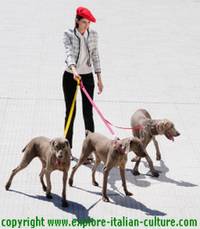
Not only goldfish are protected by Italian laws. On new construction sites work must stop if a cat colony is discovered so the cats can be re-homed, and at fairgrounds, no animal can be offered as a prize.
The city of Rome has also cracked down on negligent pet owners by introducing fines for those who don't take their dog for regular walks and in Turin the law is even more specific - dog owners can be fined up to five hundred euros if they don't walk their dogs at least three times a day.
It's not terribly clear how this legislation will be enforced as pets are of course unaware of their newly-acquired rights and so can't complain if their owners don't comply. And given that dog owners in Italy can sometimes be less than conscientious about picking up poop after their dogs it may be a while before these laws have any effect.
And this leads to some interesting facts about dogs too. One town in Northern Italy is at least trying to sort out the problem of unwanted poop. It has stated its intention of creating a DNA database of all registered dogs and testing droppings left on pavements and in parks to identify the culprit. Owners who fail to clean up after their pets will the be fined.
Yes, you read that right - we’re talking about DNA samples of dogs and then DNA tests on dog poop.
With strange animal facts like that as part of everyday life, is it any wonder we love Italy!
Strange animal facts - Number nine: Dirty Dancing for Dogs
Forget animal walking - what about animal dancing?
Ever since dogs were first domesticated, probably in China about fifteen thousand years ago, they have been put to work. In the days of ancient Roman animals dogs were used according to their breed to fight, hunt, guard, track, warm their owners' beds and act as companions.

Here is one of those lesser known but still interesting facts about dogs. Dog shows where pure bred dogs were judged according to how well they met a standard for their breed did not begin until the mid-nineteenth century in England. The most famous is without doubt Crufts which, then known as the "First Great Terrier Show", first took place in 1891.
Still not satisfied, humankind's competitive spirit saw the development of the obedience and agility events. Later still the 'heel work to music' contest was introduced at the Pacific Canine Show Case in British Columbia, Canada, in 1991 and later in a number of smaller dog shows in the U.K. from 1996.
It eventually became a formal competitive element at Crufts in 2006. Dogs and their owners are judged on synchronization, rhythm, precision of movement - and enjoyment. This is now one of the most popular events in dogs shows the world over.
So now owners can dance with their dogs without it being thought of as strange. But in Italy, not to be outdone by Crufts and with an ever-present need to give us yet more strange animal facts, not only have formal classes in doggy-dancing taken off but in one northern town, a 'doggy disco' is held every year at which owners can rumba with their retriever or polka with their poodle - and dogs can eye up the doggy talent on offer.
"If you have the right music and moves", they say, "any dog can dance. Even age doesn't matter".
Strange animal facts - Number ten: truffle pigs eat, truffle dogs go to university
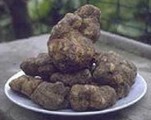
On the face of it, the truffle doesn't have a lot going for it. It looks a bit like a dog turd and smells like sweaty socks. Truffles are fussy about where they grow, preferring to stay underground but only in potassium rich soils and only under certain trees - mainly hazelnut and oak. And no-one has yet found a way of cultivating them.
But truffle hunting is a serious, mysterious and highly competitive business. The truffle hunt is like some kind of ritual dance. Often taking place at night, no torches or lights are used for fear of drawing the attention of rival hunters, and hunters who do by accident or bad planning encounter each other are careful to reveal nothing. Some go so far as to have decoy dogs strategically placed and trained to dig indiscriminately to distract other hunters and their dogs.
For many years only pigs were used to hunt out truffles, and then only female pigs. They were particularly good hunters because many types of truffle produce a scent similar to a male pig sex hormone which female pigs can sniff out from miles away. But unfortunately, although they were excellent truffle-finders, pigs have one major drawback when it comes to truffle hunting.
Yes, it's another of those strange animal facts: pigs love to eat truffles.
And when one kilo of truffles can bring thousands of euros, hunters really cannot risk their livelihood going down the throat of their pig. Hence the growing popularity of the Italian truffling dog: the 'Lagotto Romagnolo'.
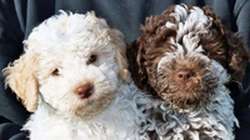
The Lagotto is one of the hunting Italian dog breeds, a member of the retriever and water-dogs group. A working animal whose sole function is truffle-hunting, he is a bouncy, energetic dog who performs his job with passion and efficiency thanks to his natural gift for searching - and a sensitive nose.
But having a natural ability is not enough, and here's where something relatively normal becomes one of Italy's strange animal facts.
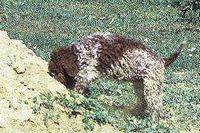 A dog hunting truffles
A dog hunting trufflesSerious truffle-hunter owners enrol their dog into the 'Universita dei Cani Tartufo' - the University of Truffle Hunting Dogs. The 'University' has been run in the north of Italy since the 1880s by four generations of a truffle-hunting family.
It's an exclusive school which provides rigorous training for the dogs and their handlers, including exercises involving locating hidden truffles and perfecting the fine art of excavating truffles.
It can take up to four years for a dog and his handler to become fully trained and experienced in the art of truffle hunting. Dogs which have undergone the training and have had experience as well are enormously valuable and sometimes even the target for dog thieves.
Strange animal facts? Maybe. But next time you're enjoying your 'tartufo gelato' (yes, that's right, they even make ice cream with truffles!) in Rome's Piazza Navona (it's a speciality in the Tre Scalini bar there - yum!), spare a thought for the doggy truffle hunters who even went to university so that you could enjoy another piece of Italian life.
If you have enjoyed these strange animal facts from Italy and would like to learn more about how animals reflect Italian culture, here's where to go
Books:
Bau Beach: Storia e storie della prima spiaggia per cani Italiana: Patrizia Daffina. Published Leconte, 2005.
The history of Bau Beach. An entertaining, informative read about Italy's first doggy beach. Unfortunately available only in Italian but a good read for anyone with even a basic understanding of the language. Available from the Bau Beach website (see below).
Websites:
Bau Beach: www.baubeach.it
This site is mostly in Italian but worth a visit for the pictures alone! It may be one of Italy's strange animal facts, but it always cheers me up on a rainy day to see photos of the animals enjoying themselves - and it always makes me sad to see the many abandoned dogs they've taken in to re-home.
Also gives links to other Italian animal welfare organizations.
Available in English as well as Italian this is an informative, well written site looking at the history and culture of the cat sanctuary and some of the people who have worked there.
It includes information about "Adopt at a Distance" and has an option whereby you can choose a cat to sponsor. For cat-lovers it also has a number of pictures of the cats of Rome which can be downloaded free as screen savers.
Lagotto Romagnolo: www.lagotto.net
The site of an Italian breeder of the truffle hound. Some pages are available in English as well as Italian and the site is well worth having a look at, if only for photos of those so cute puppies! Also has links to other related pages including the Italian national Lagotto breeders' website.
And finally, visit:
Bau Beach. If you are staying in Rome during the summer, have a car and a spare day, why not try experiencing some strange animal facts for yourself? Go and have a look at Bau beach - you don't need a dog to get in!
It is located about forty kilometres north-west of Rome in the coastal Maccarese district. The drive is fairly easy as you don't need to go anywhere near the centre of Rome itself.
If coming from Rome, take the road signposted 'Fiumicino' (A91) and from there the A12 to Maccarese. Head for Torre Maccarese but then take the Viale Maria and left off that, the Via Priaia a Mare. Bau Beach is situated on that road.
Have a look at this interactive map
to show you the way to Bau Beach.
Think these are strange animal facts?
Have a look at how the ancient Romans treated their animals
Here are some other best Italian beaches for pets
Thinking of traveling with your pet to Italy?
Here's a page about how to deal with the pet travel regulations
Here's our overview page about
animals and Italian culture



